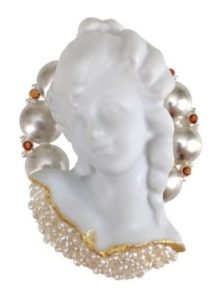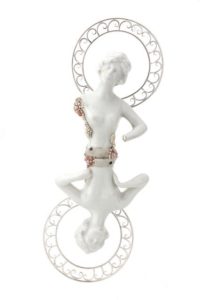Meet Kayla Staigvil, the first of our featured 2017 LEAP finalists. Her lavish and eccentric jewelry uses porcelain doll sculptures originating from the Victorian Era. Mirroring the effects of Kintsugi, a Japanese ceramic technique and philosophy, the sculptures are often highlighted using gold or silver foil. Read on to learn more about the artist and her process. And stop by The Store to shop her work which will be available in The Store through the end of March.
 Tell Us About Your Work.
Tell Us About Your Work.
My work deals with the themes of resurrection and growth. Through using mythological archetypes, the eternal transformation pattern creates a whole, allowing a connection to deal with our own mortality. In my current work, porcelain doll fragments from the Victorian era are used. Through the acts of repairing and reclamation, I am continuing their life cycle in combination with historical metalsmithing techniques. It is important to me to preserve the broken doll forms in my jewelry by giving new life as different objects. Their broken forms are often highlighted using silver or gold foil to mimic the effects of Kintsugi, a Japanese ceramic technique and philosophy. My intent is that viewers take pleasure in observing beauty in my work and in doing so, give further life to the pieces.
Why Were You Drawn to Jewelry?
I cannot precisely define what exactly drew me into making jewelry. I don’t know of a time where I wasn’t making, whether it was drying flowers in books, drawing, or rearranging bits and pieces of costume jewelry as a child. As I grew older, my perception of what art was probably narrowed to the classical sense of fine art. In college, I took my first true metals class and something clicked, it just felt right. Perhaps it was a love of objects or the ability to make a physical thing based on a drawing, it just felt extremely satisfying to do.
Most of my design inspirations come from the Art Nouveau period. The jewelry of Rene Lalique, whose eccentric and often lavish designs were celebrated, with precious metals and gemstones being the focal points. While highly labor intensive, these works were neither monumental nor mass-produced. What truly mattered was the artist’s hand and how mundane materials transcended into works of art.
What is the Best Piece of Advice you received as an Artist?
The best advice I have received as an artist would be from Bob Ebendorf, who said that the ability to play is essential in making work. Playfulness allows you to keep from becoming stale or stiff in creating. The act of playing gives a sense of flexibility and allows your mind to think in ways that may not always be completely obvious at first.
What Advice Would You Give Others Considering a Career In Art?
My advice for others seeking a career in the arts would be to not be afraid of hard work and to be true to yourself. Do what makes you happy, but also be aware of historical and contemporary issues because these events inform your subconscious even if you don’t realize it. Hard work is essential in the arts; you are responsible for yourself and need to be disciplined in focusing on your own work. Others may feel that you’re being selfish, but ultimately creativity is something some people need to do for their own well-being.
 How Will the LEAP Award Help With Your Practice?
How Will the LEAP Award Help With Your Practice?
The LEAP Award will help me by showcasing my work in a setting outside of the normal space that I actively have shown in. I am just starting to exhibit the body of work that will be featured and am very excited, as I grew up near Pittsburgh. I feel very grateful to be able to show my work in a city that represents home.


